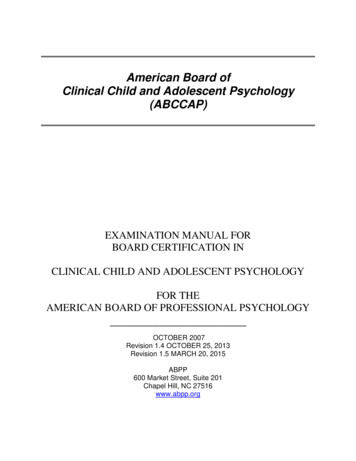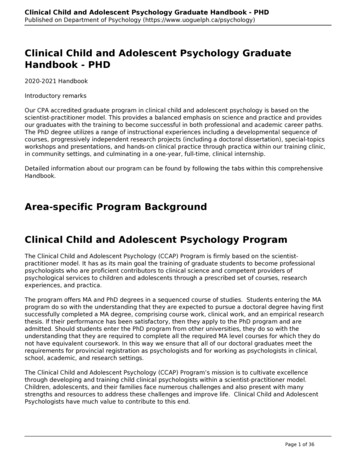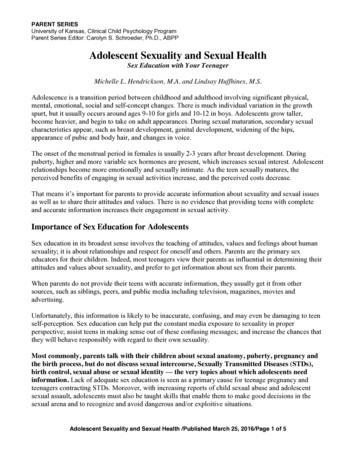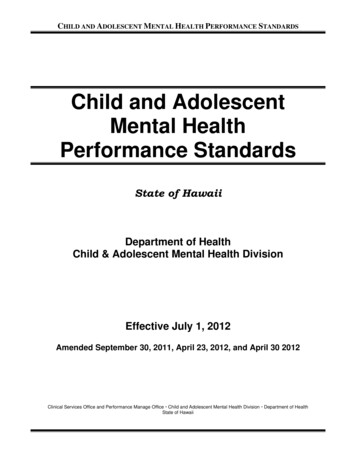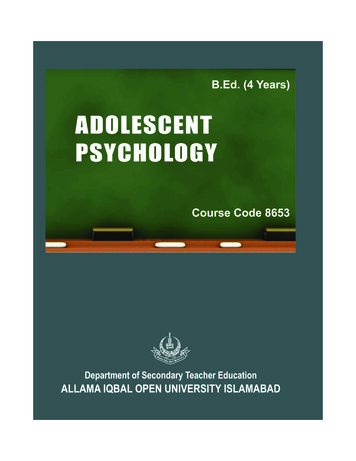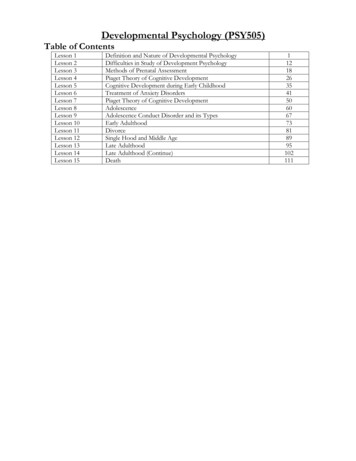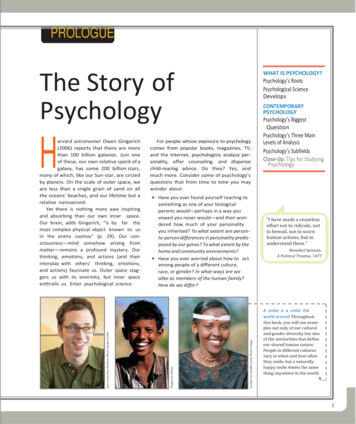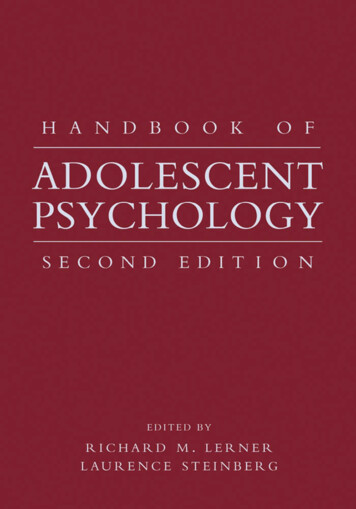
Transcription
H A N D B O O KO FADOLESCENTPSYCHOLOGY EDITED BYRICHARD M. LERNERL AU R E N C E S T E I N B E R GJOHN WILEY & SONS, INC.
H A N D B O O KO FADOLESCENTPSYCHOLOGY EDITED BYRICHARD M. LERNERL AU R E N C E S T E I N B E R GJOHN WILEY & SONS, INC.
This book is printed on acid-free paper. oCopyright 2004 by John Wiley & Sons, Inc. All rights reserved.Published by John Wiley & Sons, Inc., Hoboken, New Jersey.Published simultaneously in Canada.No part of this publication may be reproduced, stored in a retrieval system, or transmitted in any form orby any means, electronic, mechanical, photocopying, recording, scanning, or otherwise, except aspermitted under Section 107 or 108 of the 1976 United States Copyright Act, without either the priorwritten permission of the Publisher, or authorization through payment of the appropriate per-copy fee tothe Copyright Clearance Center, Inc., 222 Rosewood Drive, Danvers, MA 01923, (978) 750-8400, fax (978)646-8600, or on the web at www.copyright.com. Requests to the Publisher for permission should beaddressed to the Permissions Department, John Wiley & Sons, Inc., 111 River Street, Hoboken, NJ 07030,(201) 748-6011, fax (201) 748-6008.Limit of Liability/Disclaimer of Warranty: While the publisher and author have used their best efforts inpreparing this book, they make no representations or warranties with respect to the accuracy orcompleteness of the contents of this book and specifically disclaim any implied warranties ofmerchantability or fitness for a particular purpose. No warranty may be created or extended by salesrepresentatives or written sales materials. The advice and strategies contained herein may not be suitablefor your situation. You should consult with a professional where appropriate. Neither the publisher norauthor shall be liable for any loss of profit or any other commercial damages, including but not limited tospecial, incidental, consequential, or other damages.This publication is designed to provide accurate and authoritative information in regard to the subjectmatter covered. It is sold with the understanding that the publisher is not engaged in rendering professionalservices. If legal, accounting, medical, psychological or any other expert assistance is required, the servicesof a competent professional person should be sought.Designations used by companies to distinguish their products are often claimed as trademarks. In allinstances where John Wiley & Sons, Inc. is aware of a claim, the product names appear in initial capital orall capital letters. Readers, however, should contact the appropriate companies for more completeinformation regarding trademarks and registration.For general information on our other products and services please contact our Customer Care Departmentwithin the United States at (800) 762-2974, outside the United States at (317) 572-3993 or fax (317) 5724002.Wiley also publishes its books in a variety of electronic formats. Some content that appears in print maynot be available in electronic books. For more information about Wiley products, visit our web site atwww.wiley.com.Library of Congress Cataloging-in-Publication Data:Lerner, Richard M.Handbook of adolescent psychology / Richard M. Lerner and Laurence Steinberg.—2nd ed.p. cm.Includes bibliographical references and index.ISBN 0-471-20948-1 (cloth)1. Adolescent psychology. I. Steinberg, Laurence D., 1952– II. Title.BF 724.L367 2004155.5—dc212003049664Printed in the United States of America.10 9 8 7 6 5 4 3 2 1
ContentsContributorsvForewordviiPrefaceix1. The Scientific Study of Adolescent Development: Past, Present,and FuturePART ONE1FOUNDATIONS OF THE DEVELOPMENTALSCIENCE OF ADOLESCENCE2. Puberty and Psychological Development153. Cognitive and Brain Development454. Socialization and Self-Development: Channeling, Selection,Adjustment, and Reflection855. Schools, Academic Motivation, and Stage-Environment Fit1256. Moral Cognitions and Prosocial Responding in Adolescence1557. Sex1898. Gender and Gender Role Development in Adolescence2339. Processes of Risk and Resilience During Adolescence: LinkingContexts and Individuals263iii
ivContentsPART TWOSOCIAL RELATIONSHIPS AND SOCIALCONTEXTS IN ADOLESCENCE10. Adolescence Across Place and Time: Globalization and theChanging Pathways to Adulthood29911. Parent-Adolescent Relationships and Influences33112. Adolescents’ Relationships with Peers36313. Contexts for Mentoring: Adolescent-Adult Relationships inWorkplaces and Communities39514. Work and Leisure in Adolescence42915. Diversity in Developmental Trajectories Across Adolescence:Neighborhood Influences45116. Adolescents and Media48717. The Legal Regulation of Adolescence523PART THREE ADOLESCENT CHALLENGES, CHOICES,AND POSITIVE YOUTH DEVELOPMENT18. Adolescent Health from an International Perspective55319. Internalizing Problems During Adolescence58720. Conduct Disorder, Aggression, and Delinquency62721. Adolescent Substance Use66522. Adolescents with Developmental Disabilities and Their Families69723. Volunteerism, Leadership, Political Socialization, and CivicEngagement72124. Applying Developmental Science: Methods, Visions, and Values74725. Youth Development, Developmental Assets, and Public Policy781Afterword: On the Future Development of Adolescent Psychology815Author Index821Subject Index845
ContributorsManuel Barrera, Jr.Arizona State UniversityDavid P. FarringtonUniversity of CambridgePeter L. BensonSearch InstituteThaddeus FerberForum for Youth InvestmentRobert W. BlumUniversity of MinnesotaCelia B. FisherFordham UniversityJeanne Brooks-GunnTeachers College, Columbia UniversityConstance A. FlanaganPennsylvania State UniversityB. Bradford BrownUniversity of Wisconsin-MadisonUlla G. FoehrStanford UnversityNancy A. Busch-RossnagelFordham UniversityNancy L. GalambosUniversity of AlbertaLaurie ChassinArizona State UniversityJulia A. GraberUniversity of FloridaW. Andrew CollinsUniversity of MinnesotaBeatrix HamburgWeill Medical CollegeBruce E. CompasVanderbilt UniversityDavid HamburgCarnegie Corporation of New YorkLisa M. DiamondUniversity of UtahMary Agnes HamiltonCornell UniversityJacquelynne S. EcclesUniversity of MichiganSteven F. HamiltonCornell UniversityNancy EisenbergArizona State UniversityPenny Hauser-CramBoston Collegev
viContributorsLisa HenriksenStanford University School of MedicineKaren PittmanForum for Youth InvestmentAndrea HussongUniversity of North Carolina Chapel HillJennifer RitterArizona State UniversityDaniel P. KeatingUniversity of TorontoDonald F. RobertsStanford UniversityMary Wyngaarden KraussBrandeis UniversityAlan RogolUniversity of VirginiaReed LarsonUniversity of Illinois,Urbana/ChampaignRitch C. Savin-WilliamsCornell UniversityBrett LaursenFlorida Atlantic UniversityRichard M. LernerTufts UniversityTama LeventhalTeachers College, Columbia UniversityMarc MannesSearch InstituteBrooke S. G. MolinaUniversity of Pittsburgh Medical CenterAmanda Sheffield MorrisUniversity of New OrleansJeylan T. MortimerUniversity of MinnesotaElizabeth S. ScottUniversity of VirginiaLonnie R. SherrodFordham UniversityJeremy StaffUniversity of MinnesotaLaurence SteinbergTemple UniversityElizabeth J. SusmanThe Pennsylvania State UniversityRyan TrimArizona State UniversityChristopher UggenUniversity of MinnesotaKristin Nelson-MmariUniversity of MinnesotaSuzanne WilsonUniversity of Illinois,Urbana/ChampaignJari-Erik NurmiUniversity of JyvaskylaJennifer L. WoolardGeorgetown University
ForewordLike snapshots of a growing family (and I use the metaphor “family” rather than“child” because fields of study band together multiple personalities), subsequent editions of a scholarly handbook can reveal phenomenal changes. Imagine family photographs taken 25 years apart. You might hardly recognize the group as the same family.In the case of adolescent study, the 25-year period between Handbook editions hascaused transformations every bit as consequential as those we would see in a humanfamily during a similar time span. From my reading of this splendid current Handbook, the changes have been entirely to the good.As the editors correctly note, the term adolescence has been with us for centuries, butthe systematic examination of it for scientific purposes really began with G. StanleyHall in the early 1900s. Hall was a man of immense dedication to the healthy development of young people. He convinced America to create playgrounds for its youth; hehelped build the new discipline of development psychology; and he trained many ofits early leaders. Yet Hall’s own pioneering writings on adolescence bent that youngbranch in ways that would misdirect the field, and much of its public audience, for mostof the ensuing century.Hall’s influences were 19th-century Bildungsromanen whose authors wrote romantically of youthful Sturm und Drang, a brilliant young “psych-analyist” Sigmund Freudwhom Hall introduced to America (and who had been reading those same Germannovels), and trendy evolutionary theories that confused the ontogenesis of individualsand species. The latter set of influences were so far-fetched and ultimately inflammatory that scientists soon came to ignore this entire line in Hall’s writings. But his visionof adolescence as a turbulent, trouble-ridden period that was at best a transition tosomething saner—if the youngster did not first self-destruct—foreshadowed what wasto become the society’s dominant view of youths as walking problems. That vision wasto be elaborated in numerous ways beyond any imaginings that Hall could have had.These ways led to ill-founded scientific studies as well as poor public policy advice.The present Handbook is a world apart, for reasons both sensible and profound. Forone thing, it is refreshing to read a collection of studies portraying adolescence as a fullcolored, rich experience in itself, rather than only as a transition toward something oraway from something. There are many highpoints in the collective portrayal of youthembodied in this Handbook, and I do not mean to slight any of them by mentioningothers, but I was especially struck by the lush array of interests, capacities, and meaningful youthful activities that emerges from many of the chapters in this handbook.From the cognitive to the moral, from the academic to the civic, in relations with peers,parents, and society on its most global level, adolescents in this Handbook are shownvii
viiiForewordas active and able players in the world. They are not seen as unwitting pawns of theirown uncontrollable desires or helpless victims of external forces beyond their control.The young people in this Handbook reason powerfully; make their own choices abouttheir social and sexual relationships; adapt to their schools in a manner consistent withtheir own motives and concerns; navigate the complexity of influences that they encounter in their families, neighborhoods, mass media, and legal system; and end upforging their own judgments about who they are and what they believe in. Sometimestheir judgments work for the better, sometimes for the worse. There are real risks andcasualties associated with this age period, and the Handbook examines several of themost prominent ones. This we have long known. But there is also an infinite promiseand positive excitement associated with youth. This, too, has long been known but perhaps was put out of mind too often in our initial century of adolescent research. Thecurrent Handbook merits our thanks for bringing the more positive, and accurate,characterization back to the fore.A few years ago, the Society of Research in Adolescence indulged itself by arranging its biennial conference in sunny San Diego. An effect of the climate was that, at anytime during the conference, large numbers of prominent adolescent researchers couldbe found seated around the hotel swimming pool. Perhaps as an excuse to hang outthere myself—but also, I must admit, due to my sincere puzzlement about the matter—I took the opportunity to conduct an informal survey on the following question: Whatis adolescence?Notably, none of the 20-or-so researchers whom I collared settled upon a demarcated age period (say, “twixt twelve and twenty”) as their final answer. (Here I shouldprobably tweak the present editors for their designation of “the second decade of life”in their Preface, although I am sure that this was not meant to be their consideredscientific definition of the term.) Intead, the answers noted benchmark experiencesthat bounded the period in a developmental sense. The designated benchmarks variedamong researchers, but there were commonalities in the responses. Most common ofthe initiating benchmarks was puberty. The closing benchmark was harder to capturein a word or phrase: it was experiential in nature, and it often touched on the Eriksonian notion of psychosocial identity—my own translation would be something like “astable personal commitment to an adult role.” Now I do not believe that this amalgam—the period between the advent of puberty and a stable commitment to an adultrole—would hold up long as a scientific definition, at least without lots of further definitional work on both ends. Yet it is not a bad place to start, and I have found myselfusing it in public lectures whenever anyone puts to me the pesky question of “What isadolescence?”I mention this here because puberty is exactly where the substantive set of chaptersin this Handbook begins, and the acquisition of social roles in its most importantsense—citizenship and civic engagement—is about where the book ends. In between,we have the whole glorious parade of exploration and growth, challenge and struggle,risk and progress. It is another indicator to me of this Handbook’s validity—and itsvalue to anyone who wishes to gain a deeper understanding of this most memorableand formative period of live.William Damon
PrefaceAccording to most social scientists, a generation is about 25 years in length. By thatmeasure, this second edition of the Handbook of Adolescent Psychology represents agenerational shift, for it was fully 25 years ago that the first edition of this volume waspublished. A cursory glance at this edition’s table of contents will show just how broadlythe field has grown in that period of time, and a careful reading of the volume’s chapters will reveal that the generational shift has been as deep as it has been broad.When the first edition of the Handbook was published in 1980, the empirical studyof adolescence, by our calculation, was barely 5 years old. Much of what was preparedfor that Handbook was, of necessity, theoretical because there was very little empiricalwork on which contributors could draw. In addition, much of the theorizing was psychoanalytic in nature, because through the mid-1970s that had been the dominantworldview among those who thought about adolescence. Now, it is fair to say that thefield has reached full maturity, or at least a level of maturity comparable to that foundin the study of any other period of development. Indeed, as we note in the first chapterof the volume, in which we review and reflect on the development of the scientific studyof adolescence, research on the second decade of life often serves as a model for research on other stages of development. As the contributions to this volume clearly illustrate, the science of adolescent psychology is sophisticated, interdisciplinary, andempirically rigorous. Interestingly enough, grand theories of adolescence, whetherpsychoanalytic or not, have waned considerably in their influence.Other generational changes can also be discerned by comparing the second and firsteditions of the Handbook. First, the study of adolescent difficulty and disturbance hastaken a backseat to the study of processes of normative development. Accordingly, although the current edition includes several chapters on the development of psychological problems in adolescence, they by no means dominate the volume’s contents. Second, our knowledge about the ways in which processes of adolescent development areshaped by interacting and embedded systems of proximal and distal contextual forceshas made the study of adolescence less purely psychological in nature and far more interdisciplinary. While psychology continues to be the primary discipline reflected in thecontents (and, of course, the title) of this Handbook, it is not the only one. Contributors to the volume have drawn on a wide array of disciplines, including sociology, biology, education, neuroscience, and law. Third, the growth in applied developmentalscience over the past decade has led to a more explicit focus on the ways in which empirically based knowledge about adolescence can be used to promote positive youth development. Several contributions to this volume reflect this emphasis.This edition of the Handbook of Adolescent Psychology is concerned with all aspectsix
xPrefaceof development during the second decade of life, with all the contexts in which this development takes place and with a wide array of social implications and applications ofthe scientific knowledge gained through empirical research. This edition is divided intothree broad sections: foundations of adolescent development, the contexts of adolescent development, and special challenges and opportunities that arise at adolescence.These sections are preceded by a foreword (by William Damon) and followed by an afterword (by Beatrix and David Hamburg), which locate the Handbook’s contributionwithin the history of the field of adolescent development.The first section of the Handbook examines the foundations of the scientific studyof individual development in adolescence. Following an introductory chapter thatoverviews the past history and future prospects of adolescent psychology as a scientificenterprise (Lerner and Steinberg), contributions in this section examine puberty and itsimpact on psychological development (Susman and Rogol), cognitive and brain development (Keating), the development of the self (Nurmi), academic motivation andachievement in school settings (Eccles), morality and prosocial development (Eisenbergand Morris), sexuality and sexual relationships (Savin-Williams and Diamond), genderand gender role development (Galambos), and processes of risk and resilience (Compas). Taken together, these chapters illustrate the ways in which biological, intellectual,emotional, and social development unfold and interact during the second decade of thelife span.The second section focuses on the immediate and broader contexts in which adolescent development takes place. The chapters in this section situate adolescent development across history, cultures, and regions of the world (Larson and Wilson); withinthe family, and especially in the context of the parent-child relationship (Collins andLaursen); within the interconnected and nested contexts of peer relationships, including friendships, romantic relationships, adversarial relationships, cliques, and crowds(Brown); in relationships with adult mentors at work and in the community (Hamiltonand Hamilton); in the settings of work and leisure (Staff, Mortimer, and Uggen); in neighborhood contexts (Leventhal and Brooks-Gunn); within the contexts defined by massmedia and technology (Roberts, Henriksen, and Foehr); and within the law (Scott andWoolard). Consistent with the ecological perspective on human development that hasdominated research on adolescence for the past two decades, these contributions showhow variations in proximal, community, and distal contexts profoundly shape and alterthe developmental processes, trajectories, and outcomes associated with adolescence.The final section of the Handbook examines a variety of challenges and opportunities that can threaten or facilitate healthy development in adolescence and explores theways in which maladaptive as well as positive trajectories of youth development unfold.The first set of contributions in this section considers threats to the well-being of adolescents, including physical illness, examined from an international perspective (Blumand Nelson-Mmari); internalizing problems, including depression, anxiety, and disordered eating (Graber); externalizing problems, including conduct disorder, aggression,and delinquency (Farrington); substance use and abuse, including the use and abuse oftobacco, alcohol, and other drugs (Chassin, Hussong, Barrera, Molina, Trim, and Ritter); and developmental disabilities, including autism, cerebral palsy, epilepsy, mentalretardation, and other neurological impairments (Hauser-Cram and Krauss). The second set of contributions in this concluding section examines three sorts of opportuni-
Prefacexities with the potential to promote health and well-being in adolescence: the promotionof volunteerism and civic engagement among youth (Flanagan); the application of developmental science to facilitate healthy adolescent development (Sherrod, BuschRossnagel, and Fisher); and the development of policies and programs explicitly designed to promote positive youth development (Benson, Mannes, Pittman, and Ferber).There are numerous people to thank for their important contributions to the Handbook. First and foremost, we owe our greatest debt of gratitude to the colleagues whowrote the chapters, foreword, and afterword for the Handbook. Their scholarly excellence and leadership and their commitment to the field are the key assets for any contributions that this Handbook will make both to the scientific study of adolescence andto the application of knowledge that is requisite for enhancing the lives of diverse youngpeople worldwide.We appreciate as well the important support and guidance provided to us by themembers of the editorial board for the Handbook. We thank Peter L. Benson, Dale A.Blyth, Jeanne Brooks-Gunn, B. Bradford Brown, W. Andrew Collins, William Damon,Jacquelynne Eccles, David Elkind, Nancy Galambos, Robert C. Granger, BeatrixHamburg, Stuart Hauser, E. Mavis Hetherington, Reed Larson, Jacqueline V. Lerner,David Magnusson, Anne C. Petersen, Diane Scott-Jones, Lonnie R. Sherrod, MargaretBeale Spencer, and Wendy Wheeler for their invaluable contributions.We are very grateful to Karyn Lu, managing editor in the Applied DevelopmentalScience Institute in the Eliot-Pearson Department of Child Development at Tufts University. Her impressive ability to track and coordinate the myriad editorial tasks associated with a project of this scope, her astute editorial skills and wisdom, and her neverdiminishing good humor and positive attitude were invaluable resources throughoutour work.We are also appreciative of our publishers and editors at John Wiley & Sons: PeggyAlexander, Jennifer Simon, and Isabel Pratt. Their enthusiasm for our vision for theHandbook, their unflagging support, and their collegial and collaborative approach tothe development of this project were vital bases for the successful completion of theHandbook.We also want to express our gratitude to the several organizations that supportedour scholarship during the time we worked on the Handbook. Tufts University andTemple University provided the support and resources necessary to undertake andcomplete a project like this. In addition, Richard M. Lerner thanks the National 4-HCouncil, the William T. Grant Foundation, and the Jacobs Foundation, and LaurenceSteinberg thanks the John D. and Catherine T. MacArthur Foundation, for their generous support.Finally, we want to dedicate this Handbook to our greatest sources of inspiration,both for our work on the Handbook and for our scholarship in the field of adolescence:our children, Blair, Jarrett, Justin, and Ben. Now all in their young adulthood, theyhave taught us our greatest lessons about the nature and potentials of adolescent development.R.M.L.L.S.March 2003
Chapter 1THE SCIENTIFIC STUDY OFADOLESCENT DEVELOPMENTPast, Present, and FutureRichard M. Lerner and Laurence SteinbergIn the opening sentence of the preface to the first edition of his classic A History of Experimental Psychology, Edwin G. Boring (1929) reminded readers that “psychology hasa long past, but only a short history” (p. ix), a remark he attributed to the pioneer ofmemory research, Hermann Ebbinghaus. A similar statement may be made about thestudy of adolescents and their development.The first use of the term adolescence appeared in the 15th century. The term was aderivative of the Latin word adolescere, which means to grow up or to grow into maturity (Muuss, 1990). However, more than 1,500 years before this first explicit use of theterm both Plato and Aristotle proposed sequential demarcations of the life span, andAristotle in particular proposed stages of life that are not too dissimilar from sequencesthat might be included in contemporary models of youth development. He describedthree successive, 7-year periods (infancy, boyhood, and young manhood) prior to theperson’s attainment of full, adult maturity. About 2,000 years elapsed between these initial philosophical discussions of adolescence and the emergence, within the 20th century, of the scientific study of the second decade of life.The history of the scientific study of adolescence has had two overlapping phasesand is, we believe, on the cusp of a third. The first phase, which lasted about 70 years,was characterized by three sorts of Cartesian splits (see Overton, 1998) that createdfalse dichotomies that in turn limited the intellectual development of the field. With respect to the first of these polarizations, “grand” models of adolescence that purportedly pertained to all facets of behavior and development predominated (e.g., Erikson,1959, 1968; Hall, 1904), but these theories were limited because they were either largelyall nature (e.g., genetic or maturational; e.g., Freud, 1969; Hall, 1904) or all nurture(e.g., McCandless, 1961). Second, the major empirical studies of adolescence duringthis period were not primarily theory-driven, hypothesis-testing investigations but wereatheoretical, descriptive studies; as such, theory and research were split into separateenterprises (McCandless, 1970). Third, there was a split between scholars whose workwas focused on basic developmental processes and practitioners whose focus was oncommunity-based efforts to facilitate the healthy development of adolescents.The second phase in the scientific study of adolescence arose in the early- to mid1970s as developmental scientists began to make use of research on adolescents in elu1
2 The Scientific Study of Adolescent Developmentcidating developmental issues of interest across the entire life span (Petersen, 1988). Atthe beginning of the 1970s, the study of adolescence, like the comedian Rodney Dangerfield, “got no respect.” Gradually, however, research on adolescent development began to emerge as a dominant force in developmental science. By the end of the 1970sthe study of adolescence had finally come of age.To help place this turning point in the context of the actual lives of the scientists involved in these events, it may be useful to note that the professional careers of the editors of this Handbook began just as this transition was beginning to take place. Acrossour own professional lifetimes, then, the editors of this volume have witnessed a seachange in scholarly regard for the study of adolescent development. Among thosescholars whose own careers have begun more recently, the magnitude of this transformation is probably hard to grasp. To those of us with gray hair, however, the change hasbeen nothing short of astounding. At the beginning of our careers, adolescent development was a minor topic within developmental science, one that was of a level of importance to merit only the publication of an occasional research article within primedevelopmental journals or minimal representation on the program of major scientificmeetings. Now, three decades later, the study of adolescent development is a distinctand major field within developmental science, one that plays a central role in informing, and, through vibrant collaborations with scholars having other scientific specialties, being informed by, other areas of focus.The emergence of this second phase of the study of adolescence was predicated inpart on theoretical interest in healing the Cartesian splits (Overton, 1998) characteristic of the first phase and, as such, in exploring and elaborating developmental modelsthat reject reductionist biological or environmental accounts of development and instead focus on the fused levels of organization constituting the developmental systemand its multilayered context (e.g., Sameroff, 1983; Thelen & Smith, 1998). These developmental systems models have provided a metatheory for adolescent developmentalresearch and have been associated with more midlevel (as opposed to grand) theories—models that have been generated to account for person-environment relations withinselected domains of development.Instances of such midlevel developmental systems theories are the stage-environmentfit model used to understand achievement in classroom settings (Eccles, Wigfield, &Byrnes, 2003), the goodness of fit model used to understand the relation of temperamental individuality in peer and family relations (Lerner, Anderson, Balsano, Dowling,& Bobek, 2003), and models linking the developmental assets of youth and communities in order to understand positive youth development (Benson, 1997; Damon, 1997).For instance, Damon (1997; Damon & Gregory, 2003) forwarded a new vision and vocabulary about adolescents that was based on their strengths and potential for positivedevelopment. Damon explained that such potential could be instantiated by buildingnew youth-community relationships predicated on the creation of youth charters, agreements that codified community-specific visions and action agendas for promoting positive life experiences for adolescents.Generally speaking, the study of adolescence in its second phase was characterize
Handbook of adolescent psychology / Richard M. Lerner and Laurence Steinberg.—2nd ed. p. cm. Includes bibliographical references and index. ISBN 0-471-20948-1 (cloth) 1. Adolescent psychology. I. Steinberg, Laurence D., 1952– II. Title. BF 724.L367 2004 155.5—dc21 200304
